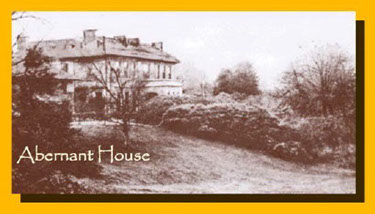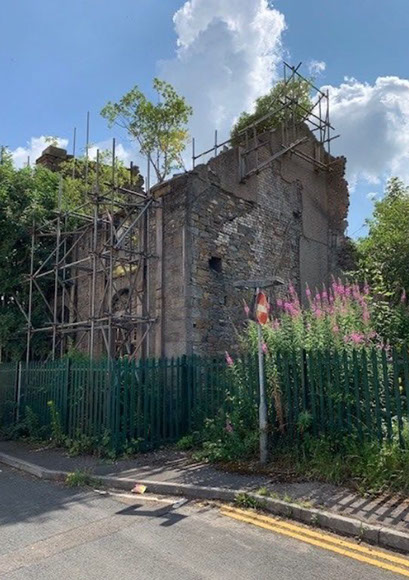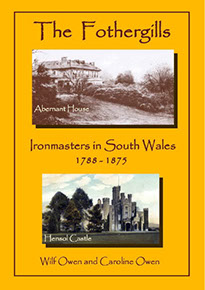
 The Fothergill Brothers
The Fothergill Brothers
Richard (1758-1821)
John Fothergill (1763-1828)
Richard Fothergill I ‘created’ a dynasty of ironworks owners, each generation headed up by a Richard – himself, number II and number III - who energetically built an empire that stretched across the coalfield in south east Wales, from Caerleon to the Cynon valley and enabled the family to live graciously and in ever rising splendour at Tredegar, Caerleon, Abernant and Hensol Castle.
This ‘family team’ business, with its roots in Westmorland, was ever expanding until the introduction of the highly competitive Bessemer method of steelmaking in the mid-1850s, when Richard III (1822-1903) plunged into electoral politics and following the ‘crash’ of the mid-1870s, with his sons, Richard IV and Sydney, secured the family wealth through ‘asset stripping’ and entering the coal trade.
The tale of the four ‘Richard Fothergills’ is told well in The Fothergills by Wilf & Caroline Owen (2022), but this booklet, illustrated with helpful maps, admits to knowing little “about John except that he married Mary, the daughter of the Reverend Matthew Monkhouse" and that was in 1785. No known portrait of either John or Richard 1 exists. Secondary sources are generally silent about John Fothergill and his family. To ‘find’ John Fothergill, his wife and family, we need to dig into the digital genealogical archives that have become available online during the past decade. And we need to search the Cumbria Archives in the Fothergills’ homeland. Sarah Richard (Chartism eMAG Family History Editor) is engaged on both these tasks.
These sources help to explain the business connections and decisions, the movement and choice of locations taken by the brothers. In fact, research reveals two Rev Matthew Monkhouse’s, father and son, living in Westmorland. John Fothergill’s wife was Mary, but she was the daughter of Monkhouse senior, not the iron founder.
Overshadowed by his elder brother and business partner, John Fothergill does not appear in the partnership indentures and property agreements featured by John Lloyd in The Early History of the Old Iron Works (1906). Until at least 1803, he did not hold any financial or managerial role in the Tredegar works. In the mid-1790s, he was preoccupied with the management of a charcoal fired iron furnace that Matthew Monkhouse had acquired in the Forest of Dean, near Newent. Reserved by nature and circumstance, and lacking the ‘supposed’ capital that his brother flaunted, John never sought the public stage like Richard did. Both his sons, Richard and Matthew, have been ignored by industrial historians; supposedly they were not seen as following their father into the iron industry. Living in Westmorland, they missed the pioneering days of iron-making, witnessed by their cousins – Richard (II), Thomas and Rowland. Richard Fothergill erected a dwelling on the west bank of the river opposite the Sirhowy works and in 1795-6 moved his family there from Clapham, where for at least a decade, he had been a successful property developer. John did not move his family to the district until after the tragic death of Mary in 1803. It was then that he became fully involved in the Tredegar works, eventually taking occupancy of the Tredegar company farm of Cefn Rychdir (p. Bedwellty) above the Rhymney, and which his son Matthew was farming long before he married in 1817.
John’s memorial in Bedwellty church reads “formerly of Hutton Park Westmoreland, late of Tredegar Ironworks in this parish”. Matthew is buried at Bedwellty churchyard.
For although not ‘iron men’, John Fothergill successfully placed his sons at the very heart of Tredegar’s business operation and their careers were shaped by the profits of iron production at Tredegar. Richard, a merchant, managed the Company Shop for many years and Matthew appears to have taken on the role of the Company’s estate manager for the parish of Bedwellty, feeding the workers, their families and the horses and occupying himself at least two of the company’s farms himself.
Mary Fothergill’s brother, Matthew Monkhouse junior was married to Bridget Atkinson. Her bachelor uncle, Thomas Atkinson, had been one of the leading partners at Sirhowy since its establishment in 1778. His will (proved 1791, Cumbria Archives) was threatened by a challenge in the Court of Chancery. Between 1791-93, Monkhouse took control of Atkinson’s estate on behalf of his wife’s elders to sort out matters.
He was particularly concerned to secure Atkinson’s shares in the Sirhowy furnace.
Monkhouse gave up his Selside curacy in 1794, when Richard Fothergill agreed to be his partner at Sirhowy and they successfully reached a 50-50 Agreement with William Barrow, the works ironmaster. Following the death of Matthew Monkhouse, senior in 1797, they bought out Barrow, with Fothergill paying £3500 for 7/24ths of Sirhowy and Llangrwrrney forge. (J. Lloyd,1906, pp 145-150)
At this stage, Richard Fothergill knew little about iron making and nothing about the coalfield strata and its raw materials. Richard’s forte, was raising capital and organising building projects. During the period 1795 to 1800, Fothergill was busy finding backers for his plans to increase the production capacity of the Sirhowy works with a second furnace and also start up the Union ironworks near Rhymney Bridge and the nearby Tredegar works – both on ‘green field’ sites. In technical matters he relied heavily on local recruits from the Merthyr industry as advised by William Head, the Sirhowy works agent. It was in this pioneering period that Fothergill recruited Thomas Williams o’r Waun, father of Zephaniah Williams (the Chartist), as a ‘fixer’.
The construction workforce for these projects was recruited from the Merthyr district and from the countryside of Breconshire. Both of the Fothergill brothers, Monkhouse nor Head spoke Welsh. Williams, not only spoke Welsh, he was immersed in the local dialect. He was a practical man, from farming stock in the Abertysswg district of the Rhymney valley; a miner from his youth, he was familiar with the geological strata and the communities of the Gelligaer and Bedwellty parishes. He had worked as Steward for the Dowlais company, managing and provisioning men, hewing coal and ironstone, tunnelling and building in stone and timber. He appreciated that the essential requirement to keep a loyal workforce was to maintain a plentiful supply of food and beer.
Running the public house at the Waun, he became a victualler, available to other employers. His importance to Fothergill is signified by his decision to move his family home to the parish of Llangynidr and join forces with two Bristol merchants and a London business man as the partners of the Union Company established in 1800. They oversaw the erection of a furnace, associated works, a manager’s house and a terrace of houses for key workers. And importantly, there were no food riots at Sirhowy or Rhymney, unlike Merthyr where in 1800 men were sent to trial in Cardiff and two were hanged. However the sudden death in 1803 of his wife, following the birth of Ann, caused Thomas Williams to withdraw from the partnership. With assistance from Crawshay’s office at Cyfartha, he retrieved £3000 capital and a property lease from the Manor of Abercarn in Penmain. From 1800 onwards, it was the Tredegar works, south of his house, that absorbed Fothergill’s attention, so he seems to have accepted that Williams had completed his usefulness at Rhymney and supported Williams’ ambition to take advantage of the Sirhowy tramroad and the prospect of a mining bonanza in the mid-Sirhowy valley. The Tredegar Company was planning to extend its tentacles southward as far as the Argoed farms. Williams’ marriage September 1804 to Mary George, heiress of Argoed Genol would have been seen as a strategic gain by the Company (headed by Samuel Homfray, with Fothergill as Manager), as they were in the process of finalising takeover of Tredegar Estate land in the north of the valley in an Agreement (1805).
Over the next five years Williams used his Sirhowy connections, such as William Head, senior and Junior and Richard Branthwaite, to build a business as a coal and provisions merchant. They operated a syndicate of self-employed ‘chapmen’ servicing the truck shops of the valley. The ‘bubble’ burst in 1809-10 and Williams went bankrupt. Mary, his eldest daughter, married William Head (Junior) in 1812 and within twelve months William Head & Co were bankrupt too.
It was not Fothergill that Thomas Williams turned to in this business crisis, but the Harfords, a Quaker family from Bristol, whom Fothergill, had embraced as 50-50 partners, when short of capital preparing for the Tredegar project. The Harford, Partridge and Co owned the Melingriffith works, near Cardiff, which they sold in 1808-10 and purchased the Ebbw Vale works. To Fothergill’s annoyance, they shifted Sirhowy away from Tredegar’s ambit, linking the works with Ebbw Vale. He was losing his grip on the business and spending most of his time at Caerleon where his family were living at The Hall in Backhall Street. His brother was left in charge at Tredegar.
Fothergill was livid in 1817, when the lease was running out and the ground landlord refused his offer and sold the lease to the Harfords. He died five years later at Caerleon. Thomas Williams stuck with the Harfords until his death in 1825. In 1827, Zephaniah Williams renewed the ties – he became the Sirhowy Company’s mineral agent, a post he held until the Autumn of 1838.
Les James, EDITOR
Genealogy of John Fothergill, ironmaster.
Research by Sarah Richards Chartism eMAG Family History Editor
30 Jan 1785. John Fothergill (aged 21) of Selside married Mary
Monkhouse (aged 22) of Long Sleddale
The marriage was by licence and Rev Matthew Monkhouse was the second signatory on the Marriage Bond.
Her father, Rev Matthew Monkhouse was Perpetual Curate of Long Sleddale (1747 – death, aged 73 in 1797).
Her brother Rev Matthew Monkhouse was teaching at Old Hutton Free School (1775) and the Perpetual Curate of Selside with Whitwell (1780 -1794.)
Both places were Chapelries in the parish of Kendal at the time.
1762 Long Sleddale baptism, birth date same year, for Mary, daughter of Matthew and Frances Monkhouse. Mary, wife of John Fothergill, died in 1803 at Hutton Park aged 41, (which matches with her birth date 1762).
John and Mary Fothergill had six surviving children, all baptised in Kendal
• Phebe 1785. Born 2 months after her parents' marriage.
Married William Ion in Kendal in 1803.
Her father John Fothergill was named in the Allegation for their marriage licence.
The will of Richard Fothergill I (d.1821) includes a legacy to "William Ion who married my niece".
When William Ion married Phebe Fothergill he was described as "husbandman - ploughman", from New Hutton, in p. Kendal.
Agent to Capel Hanbury Leigh Esquire of Pontypool Park (1834)
13th October 1834 Their son, William Ion, jun. a grandson of John
Fothergill, married Ann George at St. Catwg’s Trevethin. who was the daughter of James George, a step brother of Zephaniah
Williams, whose father (now deceased) had married (1804) James’ widowed mother, Mary George.
Ann’s first child, Phoebe Adelaide, bpt 13 Aug 1835. William Ion jun. described as a mercer and draper in Pontypool.
• Frances 1787. Married 1816: "Monday, at Bath, Mr Abraham Rowlands, surgeon, of Nant-y-Glo Ironworks, to Frances, second daughter of John Fothergill, Esq. of Tredegar Iron-works, Monmouthshire." [Gloucester Journal 4 Nov 1816]
• Richard 1789. Magistrate and merchant in charge of the Company ‘Truck’ Shop. Married 1825 Agnes Hird, Heversham, Westmorland. Living at 18 Shop Row, Tredegar, (1841 & 1851 Census). This was the location of the Tredegar Company ‘Truck’ Shop. Died 1852 at Erwood Hall, Breconshire. Fanny Maria Fothergill, in the household of Phebe Ion (1861 Census) was a daughter of Richard & Agnes.
Richard recruited young people from Westmorland to run his business. Five members of his staff, accommodated above the shop, were born outside Monmouthshire, including Edward Swidenbank, aged 15 from Grayrigg, a village six miles from Kendal. (1841 & 1851 Census) By 1851, Edward was running his own grocer's shop in Castle Street. (Practical Family History, March 2010)
• Matthew 1792. Married 1817 Elizabeth Aubrey, at Trevethin. Described ‘ Of Cefnrychdir, farmer’. Located above the Rhymney valley, south east of Tredegar, where Philipstown, New Tredegar developed later. 340 acres (Tithe Map) - his father’s home, where he continued farming until his death, 1866, buried Bedwellty church. He also occupied Argoed, where the farm buildings were increasingly devoted to the needs of coal mining.
• Mary 1794. Married as a minor,1815 William Tuckett of Bristol, at Trevethin church (Pontypool) Elizabeth 1797. Married 1829 Evan Jenkins of Merthyr Tydfil, at Bath Abbey.
• Ann 1800. Died 1821, abode Tredegar, buried at Bedwellty.
• Isabella 1803. Died 1803 aged 12 day, a week later her mother, Mary died. Buried at Kendal.

Tredegar Company shop (in Shop Row) erected (1809-1818) as part of Samuel Homfray I ‘s planned town centre, located a short distance to the east of the Circle, close to the work’s entrance.
Bridget Atkinson was a witness at the 1785 marriage of Mary Monkhouse and John Fothergill, and someone of that name married Matthew Monkhouse in Kendal on 23 Jan 1786. On the Marriage Bond he was described as 'Clerk in the Parish of Kendal'.
There is a 1755 Long Sleddale baptism, birth date same year, for Matthew, son of Matthew and Frances Monkhouse. This is a couple of years early for Rev Matthew Monkhouse, ironmaster, if he was indeed aged 65 at death in 1822 as described in the burial register and on his monument at St. Woolos, but some newspapers give his age at death as 69 and others 70, so it seems there was some uncertainty about how old he was.
Although, five years the elder brother, Richard Fothergill was aged 30 when he married Elizabeth Rowland, also from the Kendal parish, three years after John’s marriage.
Unlike John he did not embed his family in Westmorland. They settled at Clapham, where he had successfully made money as a builder and property developer. Their first four children – Richard (1789), Phebe (1790), Elizabeth (1793), Rowland (1795) were baptised at Clapham’s Holy Trinity church. Moving to Monmouthshire, John (1796), Mary (1797), Samuel (1801) and Isabella (1804) were all baptised at Capel Waunpound, Beaufort – a chapelry, at the northern extremity of the parish of Bedwellty, served by a curate/schoolmaster (Rev Benjamin Price) appointed and paid by the proprietors of the Beaufort and Sirhowy iron works.
 Wilf & Caroline Owen, The Fothergills, 2022 can be purchased Price £5 plus £2.50 p&p Contact: calowen18@gmail.com
Wilf & Caroline Owen, The Fothergills, 2022 can be purchased Price £5 plus £2.50 p&p Contact: calowen18@gmail.com
Les James & Sue Allen, Coal, Beer and Chartism: The world of Zephaniah and Joan Williams, (Six Points, to be published 2023)









